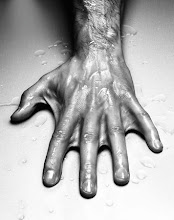
How to create a host of different locations and move between them seamlessly.
One thing I like to do is create smaller theatrical spaces within a larger space by using lighting. A fine example of what lighting can achieve in this respect is in
Antony Sher's Primo [see photo], a stonking production and one that I utterly recommend even on DVD.
Specific to Spring Awakening, lighting will help capture the intense colours that I mention in
Designing III. The
white cyclorama will literally be a blank canvas on which to project all manner of different colours.
I want to combine this highly stylized use of lighting with the flying in of impressionistic pieces of set. To create a dressing room, a mirror and portrait will be flown in at 45 degrees to each other, the eye will fill in the perspective and a 3D room will be created within the larger space. To create the reformatory corridor, barred windows will be flown in flat across the front of the stage leaving a metre and a half strip to be lit as said corridor. And so on and so forth. We will be limited by how much we can fly but even if we can only manage a few elements I think it will be worth it.
Why flying? The audience will see the items as they fly in and out between scenes and this, I hope, will create a dream-like atmosphere which will feed into the final scene of the play and also relieve the tension of the earlier scenes.
This way there will be very little physical set to move on and off which means the scenes can follow hot on each other's heels.



_filtered.jpg)


